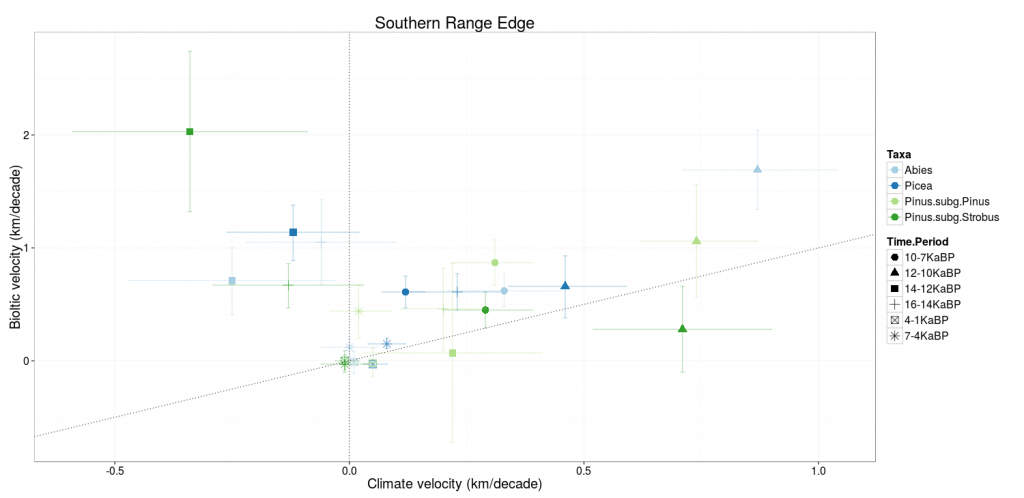A few years ago, Alejandro Ordonez and Jack Williams published a study comparing the speed of range migration to the speed of climate change during 6 periods of change in the last 16,000 years. Jacquelyn Gill described the paper with a bit of context.
They found that northern (leading) edges expanded more rapidly than southern (trailing) edges, and that tree velocities were as fast or faster than the climate velocities for the same interval. They found that not only were tree range shifts paced by climate change in general, but that biotic velocities were faster when climate change was more rapid. Populations at the leading edge were more sensitive than the trailing edge to climate change, suggesting that expansions were climate driven but mortality at the trailing edge was affected by non-climatic factors like biotic interactions. As Ordonez and Williams note, their velocity estimates (-1.7 to 2.7 km/decade) are on the low end of previous pollen-based estimates (1-10 km/decade), but slightly higher than those estimated by McLachlan et al. (<1km/decade). Meanwhile, Loarie’s climate velocity estimates for the next century are higher, ranging from 0.8 km/decade to 12.6 km/decade. To complicate matters, species have been documented to reach average velocities of 6.1 km/decade or 16.9 km/decade in response to the climate change observed in the last few decades.
This is relatively encouraging as far as expectations for trees under current climate change – ranges often expanded northward as fast or faster than the climate changed, and stuck around for awhile in the trailing edge. So far, though, it doesn’t look that rosy this time around.
Their dataset included 30 plant genera, mostly woody angiosperms. Since we mostly work on Pinaceae in the Aitken lab (but see here), I pulled out those genera for a closer look.
-

-
Movement of the nouthern range edge of Pinaceae during past periods of climate change. Dotted 1:1 line and vertical line at x origin. After Ordonez & Williams 2013
-

-
Movement of the southern range edge of Pinaceae during past periods of climate change. After Ordonez & Williams 2013
These graphs show latitudinal biotic velocity vs. latitudinal climatic velocity. Positive values are northward movement and negative values are southward. In general, the biotic velocity is ahead of the climatic velocity, though the fastest they seem to go is about 2km/decade – not exactly a rapid clip.
I wonder what’s going on with the negative climate velocities at the southern range edge. If climates to the south became more favourable, why would the range shift north?
The data was published with the paper, but as a pdf. A. Ordonez was kind enough to provide me with an excel copy. Code used to generate graphs can be found here.
Zhu, K., Woodall, C. W., & Clark, J. S. (2012). Failure to migrate: Lack of tree range expansion in response to climate change. Global Change Biology, 18(3), 1042–1052. doi:10.1111/j.1365-2486.2011.02571.x
Ordonez, A., & Williams, J. W. (2013). Climatic and biotic velocities for woody taxa distributions over the last 16 000 years in eastern North America. Ecology Letters, 16(6), 773–781. doi:10.1111/ele.12110




